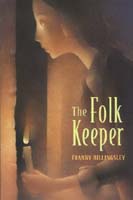The Folk Keeper

Billingsley, Franny. The Folk Keeper. New York: Atheneum/Simon & Schuster, 1999. ISBN 0-689-82876-4, hc, $16.00.

(This review originally appeared in Mythprint 37:6 (217) in June 2000.)
Reviewed by Eleanor M. Farrell
One of the finalists for this year’s Mythopoeic Fantasy Award for Children’s Literature, The Folk Keeper rings several changes on the selkie traditions of folklore. Corinna Stonewall, the book’s fiercely independent protagonist, tells the story via her written record as a “Folk Keeper,” given the task of controlling the malevolent creatures who live underground and who can wreak havoc on human activities. The main targets of the Folk are crops, herds and food-related efforts such as baking or brewing, and their focus can be diverted or channeled through the Keeper’s talents. Corinna differs from most Keepers — she is untrained, learning what she can from gossip and trading what she can for charms and other useful information. Even more important, she’s a girl, albeit one who has disguised herself in boys’ clothes to escape the drudgery of a foundling shuttled from home to home. As Corin Stonewall, she is asked to come to Cliffsend by the dying Lord Merton, who claims to have known her mother, and begins a new life at Marblehaugh Park on the rocky coasts of the Northern Isles.
Here Corinna first encounters the sea, and finds that she has a strong affinity for its tides, as well as for the seals who inhabit the waters around her new home. With the local Folk, she fares less well, as they are much more demanding and destructive than her earlier experiences suggested. Corinna had falsely claimed to have the power of the “Last Word” — an ability to make rhymes that can control the Folk; out of her depth, she attempts to learn more about the history and customs of the manor to gain some advantages over her charges.
Finian, the son of Lord Merton’s widow, Lady Alicia, and an ardent sailor, befriends the young Corin and introduces him to sailing and boatcraft, while providing some background about the isles and their inhhabitants. Corinna loses some of her defensiveness as she becomes intrigued with the tales of the magical Sealfolk, as well as her own mysterious history.
The setting of The Folk Keeper is left deliberately vague, but is reminiscent of the isles of Scotland or Ireland, a pre-industrial setting of coaches and ferries, village fairs and manors. The Sealfolk traditions and tales will be familiar to most readers, but the Folk are quite an original creation, with none of the human characteristics given to many creatures of faery. And Corinna’s own epistolary tale of attempting to find a place for herself — a familiar theme in young adult fantasy — is well-told and engaging.
